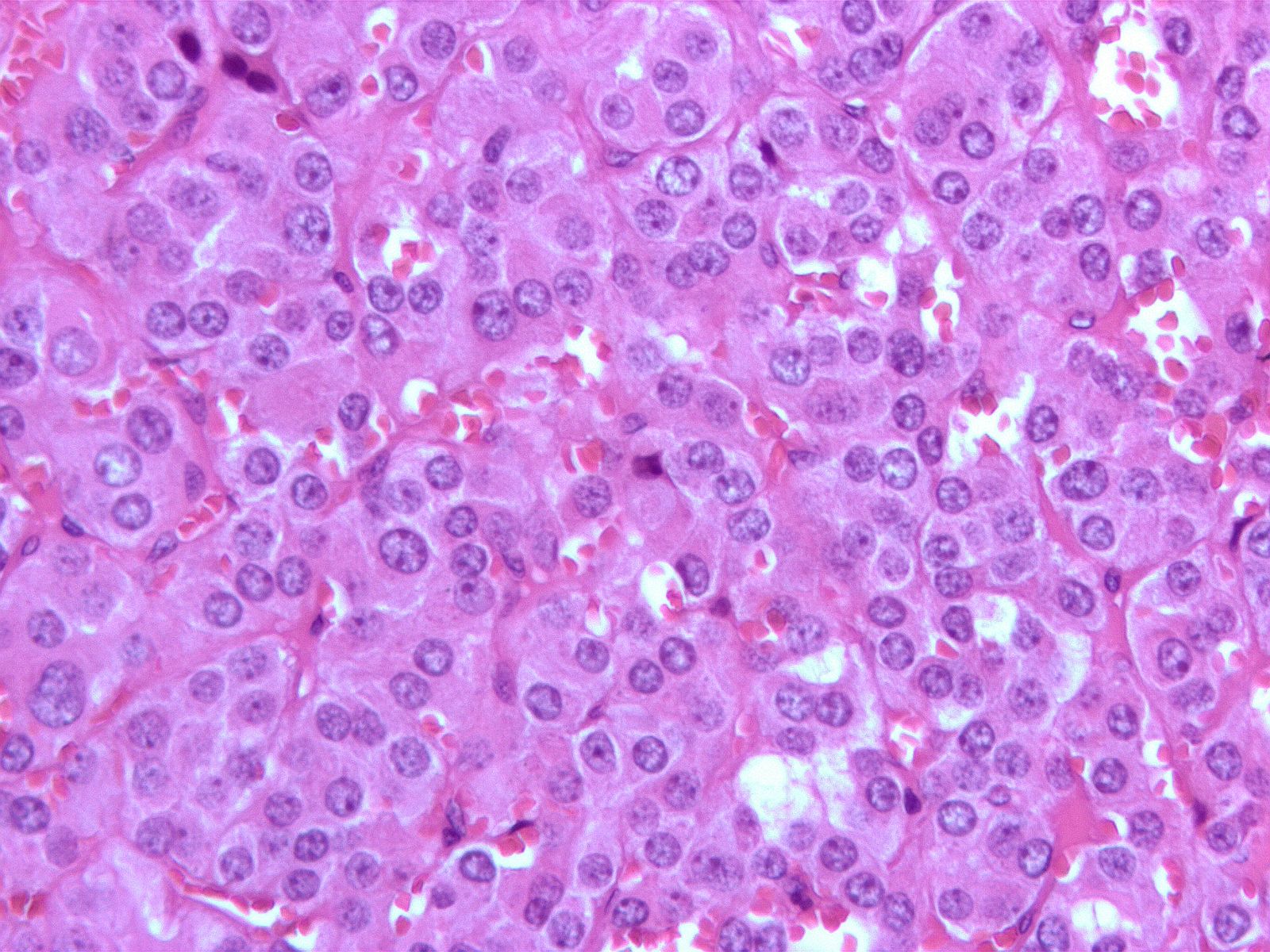Difference Between Pheochromocytoma and Neuroblastoma
Pheochromocytoma is a tumor of the chromaffin cells of the adrenal gland, which secretes catecholamines including epinephrine. A neuroblastoma is a cancer that often begins in nerve cells of the adrenal glands or in other nerve ganglia of the sympathetic system.

What is Pheochromocytoma?
Definition:
A benign tumor that secretes catecholamines, and that is found in the chromaffin cells of the adrenal gland.
Symptoms:
The main symptom is uncontrollable high blood pressure that can be persistent or occur suddenly and sporadically. This is due to the overproduction of hormones by the tumor. Further symptoms include a fast heart rate, sweating, rapid breathing rate, headache, palpitations, and chest pain.
Diagnosis and prevalence:
Blood tests showing high levels of plasma norepinephrine along with high levels of this hormone and epinephrine in the urine indicate the presence of a pheochromocytoma tumor. This type of tumor is most often seen in people who are between the ages of 20 and 50.
Causes and risk factors:
The exact cause of the condition is not known but some people are at increased risk of developing a pheochromocytoma. Such risk factors that could cause the condition include genetic disorders such as Von Hippel-Lindau disease, hereditary paraganglioma syndromes and multiple endocrine neoplasia, type 2. Scientists have found certain genetic mutations such as those of MAX genes and those of succinate dehydrogenase subunit SDHB to increase odds of having the tumor.
Treatment and complications:
Laparoscopic surgery to remove the tumor is one option, and beta blockers and alpha blocker medications to control the hypertension can also be given. Although rare, the tumor can become malignant and the cancer cells can then spread to the liver, bones or lungs. The complications from the hypertension caused by the tumor can include kidney damage, heart disease, and stroke.

What is Neuroblastoma?
Definition:
A neuroblastoma is a cancer that often begins in nervous tissue of the medulla of the adrenal glands or in sympathetic nerve ganglia, but it can occur elsewhere in the abdomen and chest.
Symptoms:
Pain in the abdominal region where more than 50 percent of tumors occur, but sometimes it is found in the chest area. If the tumor is in the abdomen, then there may be symptoms such as a change in bowel habits. A tumor in the chest may cause breathing problems and pain.
Diagnosis and prevalence:
Diagnosis can be achieved by imaging tests such as MRI and X-ray, bone marrow can be examined for cancer cells and certain metabolites of catecholamines may be seen in the urine. It can be confused with pheochromocytoma but epinephrine metabolites would not be present in neuroblastoma. Neuroblastoma is a very common cancer of infants and very young children up to age 5 years, and is not found in adults the way that pheochromocytoma is.
Causes and risk factors:
Genetic factors are thought to be involved in causing the disease, for instance, the proto‐oncogene MYCN is thought to play a role in neuroblastoma. The cancer is caused by problems with nerve cells called neuroblasts which develop during fetal development. Risk factors include having a family history of neuroblastoma.
Treatment and complications:
Surgical removal of the tumor and sometimes also chemotherapy are treatments of choice. Radiation therapy and immunotherapy are sometimes used in high risk disease cases. The main complication is metastasis or spread to the bones and liver, potentially leading to death.
Difference between Pheochromocytoma and Neuroblastoma?
Definition
A pheochromocytoma is a benign tumor that is found in the chromaffin cells of the adrenal gland. A neuroblastoma is a cancer that begins in nerve cells of the medulla of the adrenal glands or in sympathetic nerve ganglia.
Age affected
People who are 20 to 50 years old are affected by pheochromocytoma. Children younger than 5, commonly including infants are affected by neuroblastoma.
Secretions of tumor
Secretions of pheochromocytoma tumors are catecholamines, including epinephrine, norepinephrine. Secretions of neuroblastoma in the adrenals include catecholamines but not epinephrine.
Symptoms
Symptoms of pheochromocytoma include hypertension, sweating, fast heart rate, rapid breathing rate, and headache. Symptoms of neuroblastoma include pain and discomfort in the abdomen or wherever the tumor is located.
Benign or malignant tumor
In pheochromocytoma, the tumor is benign most often, very rarely malignant. In neuroblastoma, the tumor is malignant.
Causes
Pheochromocytoma is suspected to be caused by certain genetic disorders such as Von Hippel-Lindau disease, multiple endocrine neoplasia, hereditary paraganglioma syndromes , MAX genes, and genes linked to succinate dehydrogenase subunit SDHB. Neuroblastoma is due to improperly developing neuroblasts in the fetal stage and is linked to the proto‐oncogene MYCN.
Table comparing Pheochromocytoma and Neuroblastoma

Summary of Pheochromocytoma Vs. Neuroblastoma
- Both pheochromocytoma and neuroblastoma are tumors that can occur in the adrenal gland.
- Pheochromocytoma is always associated with the adrenal gland while neuroblastoma is sometimes found elsewhere.
- Both conditions can often be treated by removing the tumor surgically.
- Pheochromocytoma is found in adults, while neuroblastoma is found in young children and infants.
- Both types of tumors are believed to be caused partly by specific genetic mutations.
- Difference Between Rumination and Regurgitation - June 13, 2024
- Difference Between Pyelectasis and Hydronephrosis - June 4, 2024
- Difference Between Cellulitis and Erysipelas - June 1, 2024
Search DifferenceBetween.net :
Leave a Response
References :
[0]Astuti, Dewi, et al. "Gene mutations in the succinate dehydrogenase subunit SDHB cause susceptibility to familial pheochromocytoma and to familial paraganglioma." The American Journal of Human Genetics 69.1 (2001): 49-54.
[1]Gresh, Rene. “Neuroblastoma”. Merckmanuals. Merck & Co., 2019, https://www.msdmanuals.com/professional/pediatrics/pediatric-cancers/neuroblastoma
[2]Grossman, Ashley B. “Pheochromocytoma”. Merckmanuals. Merck & Co., 2019, https://www.msdmanuals.com/professional/endocrine-and-metabolic-disorders/adrenal-disorders/pheochromocytoma
[3]Image credit: https://commons.wikimedia.org/wiki/File:Pheochromocytoma_high_mag.jpg
[4]Image credit: https://commons.wikimedia.org/wiki/File:Neuroblastoma_cell_matruration.jpg
